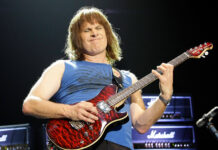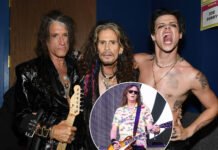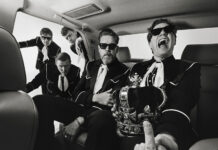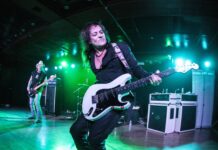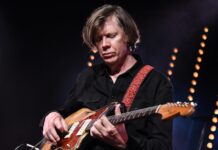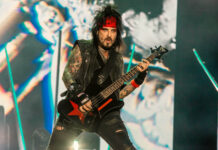
“I didn’t try to play a guitar hero solo, but it sounds like it” The Cult’s Billy Duffy reveals his ultimate guitar solo
When it comes to weird and wacky, off-the rails epic guitar solos, it’s hard to beat Billy Duffy’s wildcat lead on the Cult’s 1987 hit Love Removal Machine, from their Rick Rubin-produced album Electric. It’s big and bold in all the ways a rock solo should be, but it zigs where other solos zag. It simply doesn’t behave – there’s a messiness to it in ways that recalls Jimmy Page’s fireball solo to Led Zeppelin’s Heartbreaker.
READ MORE: Five times the Hives were the best band in the world (according to the Hives)
“I take that as a compliment,” Duffy says. “Most people like it for what it is, but there were a few people who slagged it off.”
He points to one such criticism from a friend, Dweezil Zappa. “It was quite funny, actually,” he says. “We were backstage at some arena, and he went, ‘Dude, that solo is out of tune.’ I said, ‘I know.’ Dweezil was totally floored because he couldn’t comprehend why somebody would try and make a rock ’n’ roll record and not be as concerned with perfection and timing as they were with spirit and attitude.
“I mean, we were making a rock and roll record,” he continues. “We wanted something authentic, and we didn’t get caught up in details. That solo was okay with Rick Rubin, who as far as I know, is the coolest man alive. If Rick was fine with it, I was happy to let it stand.”
Peace Sells?
Originally, Rubin wasn’t tapped to produce the Cult’s follow-up to their breakthrough 1985 album, Love. The band had spent the better part of the summer of 1986 working with producer Steve Brown (who had produced Love) at the Manor Studio in Oxfordshire recording an album to be called Peace that sound-wise (lots of guitar effects, multiple layers of overdubs) didn’t stray from hits like She Sells Sanctuary and Rain.
“The general idea was that Love had been a hit and we became a known band, so logically we didn’t want to completely change course,” Duffy says. “We were just looking to add a bit more muscle to our sound and rock more. We had already done punk rock, which became a bit restrictive, so now it was the mid-‘80s and we thought, ‘Maybe we should explore early Zeppelin.’”
Before sessions with Brown had commenced, however, the band hit a bit of a snag when, as Duffy recalls, singer Ian Astbury, had “a bit of an episode.” “It was sort of a creative crisis that led to a blowout in Italy in which Ian threw out his lyrics,” Duffy says. “We went into the studio without spending much time on the music. Ian wasn’t engaged enough, and we overcompensated with production and layering. There were too many guitars, but that was just how I normally do things. I write melodies by layering guitars.”
Dissatisfied with the results, the band decided to contact the New York-based Rubin, who had already established himself as a shining star by combining rock and hip-hop on hits by the Beastie Boys and Run-DMC (particularly their rock-rap mash-up Walk This Way with Aerosmith), and have him remix Love Removal Machine, which had already been viewed as a potential single.
Idle Hands
Rubin made his feelings known to the band in no uncertain terms. “He thought what we recorded was too busy,” Duffy says, “Although his actual words were less PC. He thought it was too messy and complicated. It didn’t hit hard enough for him. He wanted something simple and direct.”
Before remixing Love Removal Machine, however, Rubin made the proviso that he would do so only if he and the band would recut a song they liked the least on the record, Peace Dog. After doing so, the decision was quickly made to toss away all existing tracks and redo everything, with Rubin producing the band as he saw fit.
“Rick talked about AC/DC, Zeppelin and a little bit about Aerosmith,” Duffy says. “He asked, ‘Do you like those records?’ and we said, ‘Hell yeah.’ I saw AC/DC when Bon Scott was in the band, so I was very much on board. At that point, we were open to somebody who had a different vision. We weren’t precious about things at all. Rick made a lot of sense to us, and he took us on a bit of a journey. He later said something once that I quite liked – that he didn’t so much produce the Cult as he reduced us. In that way, Electric is sort of an outlier for me.”
The band traveled to New York to work with Rick. You recorded at Electric Lady Studios.
“Right. We were in the big studio downstairs – in the back of my mind, it’s where AC/DC did Back in Black. Rick had a great team – Andy Wallace was the engineer, and George Drakoulias was there. Rick had the vision.”
Rick hadn’t yet worked with a lot of full bands.
“This might have been before he produced Slayer – I’m not sure. He was very confident, but in a nice way. He believed in what he felt. He believed in the band. He got us.”
As a guitar player who had established a sound, was it hard for you to give in to Rick’s approach and let go of your effects?
“Sure. It was quite a shock. I don’t think anybody else realized or cared that I was literally flying by the seat of my pants. I was reaching back to being a teenage boy, pre-punk, listening to Mott the Hoople and Bad Company and Led Zeppelin, et cetera, et cetera. The other thing was, all the gear on Electric was rented – every stick of it.”
Before you did any recording, even for what was supposed to be the Peace album, did you play any of the material live, just to test it out?
“That’s a very good question, and I don’t think we did. No, wait – we played one song called Electric Ocean because we tried to cut it for a movie soundtrack. I know there’s a live version of it from a festival in Finland. But Love Removal, none of that was played live.
Set the scene in the studio. Rick tells the band, ‘Great song, but you’re doing too much. We’re gonna take it down to bare bones.’ Did he get you all there to rehearse as a band to make the song lean and mean?”
“Absolutely. Originally, it was three guys in the room – Ian wasn’t there because he didn’t sing with us when we were doing the backing tracks. But I remember Rick telling him, “You’re the singer, right? Go and sing!” Ian jumped in and we cut every track from the floor. Which was great because the singer is part of a team. The vocals are essential. If you’re taking away all of these guitar layers, you won’t be left with much if you don’t have any singing.”
As you mentioned, the gear was rented. That included your guitars?
“Yeah. There’s no Gretsch guitar on the song or the album, which will break everybody’s hearts. I used two rented Les Pauls.”
Your go-to guitar had been a Gretsch White Falcon. Did you feel naked without it?
“Absolutely. It was scary at first. Now, I should say that prior to the Cult, I had played Les Pauls. I got into Gretsches around 1981. So I’m playing Les Pauls through rented Marshalls – no delay or chorus or echo. I was used to having an overdriven sound, because the more saturation you have, the easier it is to play. Rick and Andy had this thing where they backed off the overdrive, and I was panicking a bit, but they found that if you backed off the gain, the amp sound became bigger. It was that sweet spot.”
Let’s get into that solo. Did you plot it out beforehand, or was it spontaneous?
“I’m a gut guy. I’ve always felt my role as a guitar player would be to serve the song, and playing a good guitar solo is part of that service. Because I had a punk rock background, I didn’t like perfection. I wanted soul, passion and guts.”
You start the solo out on this crying, sustained note. Did you at least have that planned?
“My thing with a guitar solo is, you need to know how you’re going to get in and how you’re going to get out. What happens in the middle isn’t quite as important. I did have the idea to start the solo because of a song called Violence by Mott the Hoople. There’s a break where Mick Ralphs hits a note with a wah-wah and he sustains the note while the music moved around it. I just always felt that the more you can say with the less notes, the better. There’s time to do a lot, and in some spots I went a bit mad. I was just trying to help out and do my job. It wasn’t like, ‘Hey, look at me!’”
Even so, it is a very “look at me” guitar solo.
“Well, it’s set up that way. It’s presented on a platter, isn’t it? It’s a bit of a pig with an apple in its mouth. Rick had us reconstruct the songs, and that was part of it – you needed the payoff.”
Did you play the solo live with the rest of the band?
“I honestly can’t remember how I did it. I don’t know whether I would’ve done a solo without rhythm guitar, if you know what I mean, because it would’ve just been drums and bass. It’s likely that I did it as an overdub. But the solos on that record were not really chopped together.”
The middle part of the solo – the part that Dweezil Zappa said was out of tune – it’s completely mad. It’s great, but it’s totally weird. What was running through your mind as you played it?
“I can’t recall. I wasn’t as caught up in the detail because it was a bit of a rush job. There was a lot of pressure because we knew we’d eaten up all the budget and we were on borrowed time. So my mindset was more like, ‘If everybody else is into it, I’m into it.’”
Toward the end of the song, the band goes into a full-tilt boogie and you do another solo – more of a spitfire run. None of that was on the earlier version you had cut.
“I think what had happened was, we were a live touring band and we were looking for a song to be a set ender, something quite dramatic. It was just one of those crazy “go for it” rock and roll solos. I always felt it was in the spirit of Toys in the Attic – this explosion of energy.”
After you had finished cutting everything and you listened to a playback with Rick, what were you thinking? After all, this was a pretty stark difference in the band’s sound.
“I was a little nervous. I was aware that it was certainly going to upset a bit of a gothic apple cart. But Ian was totally committed, while in the back of my mind it was like, ‘Wow, this is going to really upset people.’ With She Sells Sanctuary, I intuitively knew it was the right thing to do.”
“People are like, ‘Why don’t you make an album like that again?’ Well, because we’re not 25 anymore, living this young man’s pirate lifestyle. Electric is kind of a cartoon album of our lifestyle at that time, and it’s very important in that context. We were naive and having a lot of fun misbehaving. It was the soundtrack to sort of a misspent youth.”
There was Dweezil Zappa’s reaction, but as you said, you’ve heard the opposite from a lot of people.
“The general reaction to the Electric album is, it’s sort of a timeless rock sound. Warts and all, it’s honest. It’s a few blokes playing to their best of ability without a lot of smoke and mirrors. From Rick all the way down to the band and everyone involved, we put the hours in. We believed that good, honest rock had gotten a bit of trodden under foot with punk rock. We just believed in what we were doing.”
We should talk about the riff to Love Removal Machine. At any point, did anybody in the band say, “Oh, shit, this sounds a bit like Start Me Up”?
“No. That’s a very interesting question because it’s kind of haunted the track. Hand over heart, I never thought it was influenced by that at all. Now, does it sound like it? Well, yeah, I can see that. I didn’t know it the time. I know the version that I wrote didn’t sound like it. It wasn’t intentional.
“I don’t know where it came from. It certainly didn’t come from me owning an album with Start Me Up on it. I’ve never really owned a Stones album – I know that might horrify people. But they did write one of my favourite songs ever, Gimme Shelter. I was just never a Stonesy guy.”
The post “I didn’t try to play a guitar hero solo, but it sounds like it” The Cult’s Billy Duffy reveals his ultimate guitar solo appeared first on Guitar.com | All Things Guitar.
Source: www.guitar-bass.net

